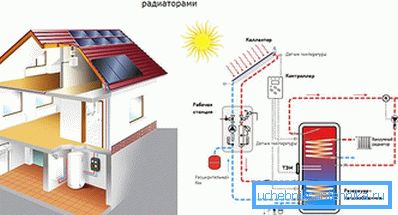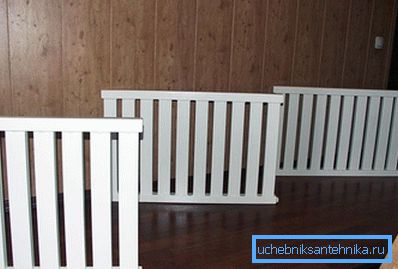Vacuum heating radiators
The main task for which the heating system serves is the effective transfer of heat from the heating device to the room. To improve the quality of heat transfer, two methods are determined: an increase in the power of the heating device and a decrease in heat loss.
If we talk about increasing power, then your expenses for heating the dwelling will increase significantly. And if you reduce heat loss, it will save you money. Efficiency (efficiency) of modern devices for heating ranges from 65 to 85%. It all depends on how much the material lends itself to thermal conductivity - the higher the thermal conductivity, the higher the efficiency. It also affects the uneven distribution of the coolant. If you want to increase the performance of the heating system and minimize heat loss, vacuum radiators will help you achieve this goal. They heat up in just a few minutes and have high heat transfer. And more importantly, such devices can be installed in a room with any heating system, be it central or autonomous.
The principle of operation and features

The appearance of these radiators is no different from a standard sectional battery. All the differences are inside the design. The radiator looks like this: horizontally placed pipes are connected vertically. The upper tube is completely closed on both sides, so you can not connect anything to it. Bottom pipe is located to connect to the heating system. In the vertical gaps under very low pressure there is a lithium bromide liquid. The coolant, passing through the bottom tube, heats the fluid in the radiator gaps.
Due to the fact that the pipes have low pressure, the secondary heat carrier boils at a temperature of 35 ° C. Therefore, as soon as the temperature in the lower pipe reaches 35 ° C, the lithium-bromide liquid begins to boil, rising up. So, it begins to condense on the inner walls of the radiator, transferring heat to them, which is distributed over the surface of the device.

This is a continuous process: condensate flows down, boils again and rises. All the action takes place at a constant temperature.
If you turn off the device, it will cool very slowly. This is the principle of operation of radiators. If we talk about the amount of coolant in the device, then in one radiator with ten sections there will be 500 ml of liquid and this is quite enough. For example, in only one section of the battery of cast iron 4 liters of water, and in aluminum - 0.35 liters. Moreover, in a standard system, the water temperature is 80 ° C, and its movement occurs in each section, which takes a long time. For a vacuum battery, however, 50–60 ° C is enough, moreover, the liquid passes only in the pipe below.

Vacuum radiators are often bought for the heating of a private house by owners of large rooms in which they need to heat large amounts of water. And this is not surprising, because by installing such a device, you will significantly reduce heating costs.
Saving money is due to the fact that the volume of coolant is reduced, and it is not necessary to heat it to 80 ° C, only 50 ° C is sufficient.
Relays and temperature sensors are built into such a system, due to which the heating stops when the temperature you set is reached. Vacuum radiators work with all types of boilers:
- gas;
- electric;
- solid fuel.
The ability of the device to interact with the solar panels is surprising. Then the costs will be almost reduced to zero. Moreover, you will forget about the emergence of "cold zones", since air plugs in vacuum radiators are not created.
Advantages and disadvantages

Here are some advantages of vacuum radiators:
- An opportunity to work with any sources of heat - electricity, gas, diesel fuel, firewood, solar battery.
- Saving both energy (up to 30%) and coolant (80%).
- Dimensions and low weight.
- Easy to install due to the lack of gaskets, valves, taps, plugs and nipples.
- The surface inside is not covered with rust and is not “salted”.
- Low hydraulic resistance.
- High efficiency (98%), thanks to the high level of return of heat.
- Small volume of the necessary heat carrier.
- Very fast heating of the device.
- The absence of "cold zones" created by air traffic jams.
- Easy care and cleaning.
- Service life is 30 years.
If we talk about the minuses, there are several:
- The high price in comparison with other heating devices.
- When depressurization boiling content is poured into the room.
- The vacuum battery begins to generate heat at a predetermined difference in temperature levels.

Due to the advantages of a vacuum radiator and the means it saves when heating a room, it is worthy of your interest. The prices for a radiator are much higher than for its standard analogues. But thanks to how much money he will save you, the price is quite reasonable. You will notice this after several months of using the device.
The price of the radiator depends on the number of built-in sections - the more, the higher it is. This is not surprising, because the number of rooms depends on the number of sections, which the radiator can heat.
To heat a room up to 75 m3 and bring it to a comfortable temperature, it is enough to purchase a radiator for 12 sections. If we talk about cast iron batteries or aluminum radiators, then it will be very difficult to achieve such an effect with the same indicators. In this case, additional expenses will be required for the insulation of the whole house: walls, floor and roof.
All this makes vacuum radiators an ideal option for those who want to heat a large house with minimal costs. Thanks to the information contained in the article, you can quickly determine whether to buy a vacuum radiator or not. If you already use this device in everyday life, then share your impressions, write comments to the article.
Video
In this video you can learn about the principle of operation of the vacuum radiator:
And in this video features vacuum radiators: